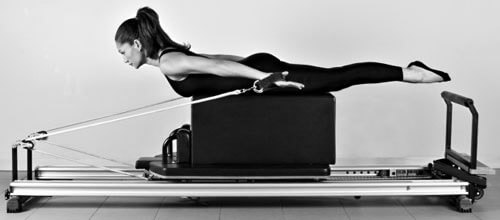
No, I’m not talking here about being eccentric, I’m reflecting on the value of eccentric exercise and how it can relate to leadership and our own balance, physically, mentally and emotionally.
Concentric and Eccentric Training
In exercise, it is all too common for muscles to be used only in one way, to contract the muscles, known as concentric training. Imagine a bicep curl, or, in the case of the pilates exercise above, the motion of pulling the arms back to the waist, which involves contracting the triceps and upper back muscles.
However, there is great value in terms of strength, flexibility and lengthening muscles by also focussing on eccentric training, most simply understood as the “return” phase of an exercise, such as lowering yourself down into a push up or dropping the arms after a bicep curl.
This morning I was working with my Pilates trainer, a discipline I’ve had for many years. When I was a beginner I focussed mostly on that standard area of muscle contraction. It was only as I developed my practice and awareness that I tuned more and more into activating different muscles and, in particular, on finding balance through both concentric and eccentric training through all exercises.
How can we work our “mind muscles” differently?
As I left my training session today, I thought to myself how, in our “mind” work, we often work muscles in only one way, the mind equivalent of a bicep curl where we put all the effort into lifting the weight, then simply uncurl the arms unconsciously with no eccentric focus to counter-balance the concentric.
Self-reflecting, I have the ability intellectually to process an abnormal amount of information very fast, so perhaps I have strong “muscles” in my mind that enable this. However, I recently was enlightened by Derek Sivers on the power of consciously thinking slowly. If I can process fast and tend to default to that, there is real value in thinking slowly.
Another example is around choosing colours to decorate a house. I am learning a lot from someone who is all about quality in design at all levels, that is key to their professional role. As they immerse themself in the process of redecorating their home, they are taking it slowly, step by step, looking at many samples of colours and textures. I realise that I would very, very quickly process all of the options, but then my result would be (say) 95% (or less!) optimal, whereas theirs will be, over time, far nearer to 100%.
Now, sometimes “perfection is the enemy of progress” at work so 90-95% is “good enough”, but other times it is worthwhile to embrace going slowly and get closer to 100% through a focus on looking things in a different way.
Now, the person who always goes fast may find it very difficult to go slow, just as the person who has that high focus on quality and goes slow may find it challenging to both go fast and to accept less than perfect results. We tend to go with our default, after all.
What if, however, we could, as practice work those “mind muscles” both concentrically and eccentrically? We would then find it far easier to choose different approaches based on differing situational needs.
Exercise like Pilates or Yoga is amazing for awareness and balance not only physically but also mentally and spiritually, but you can do the same simply in how you walk down the street or ride a bike by being aware of which muscles you use and how you use them in each step or revolution.
Similarly, you can attune to which “muscles” you utilise and how you use them when you are at work. It all starts with awareness, then to adopt practices that focus yourself on the mental equivalent of eccentric training.
Working “on” the business, not just “in” the business
In closing, I am meeting more and more business owners and leaders in recent months who have found, through shifts happening due to the pandemic, that they are working their “mind muscles” differently.
It is all too common for even the most senior leaders to spend the vast majority of their time working “in the business”, not slowing down and focussing on what drives real value, ie working “on the business”.
If you are ready to shift to working “on the business”, so your business works for you rather you feeling you have to work in it, then call me. Perhaps I can be the Pilates trainer for your “mind muscles” 🙂
Let’s talk
Book your 30-minute meeting here.
